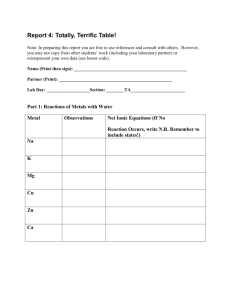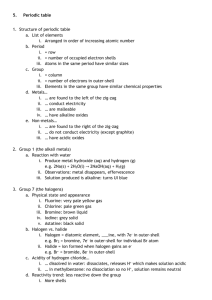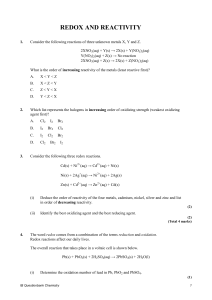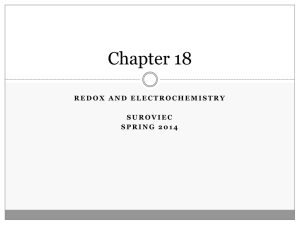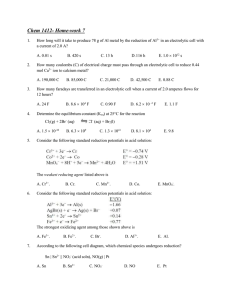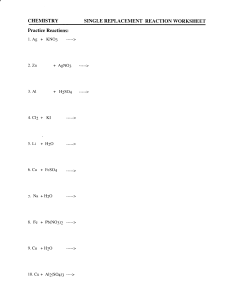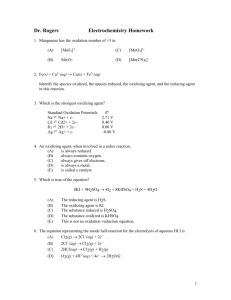Oxidation & Reduction
advertisement
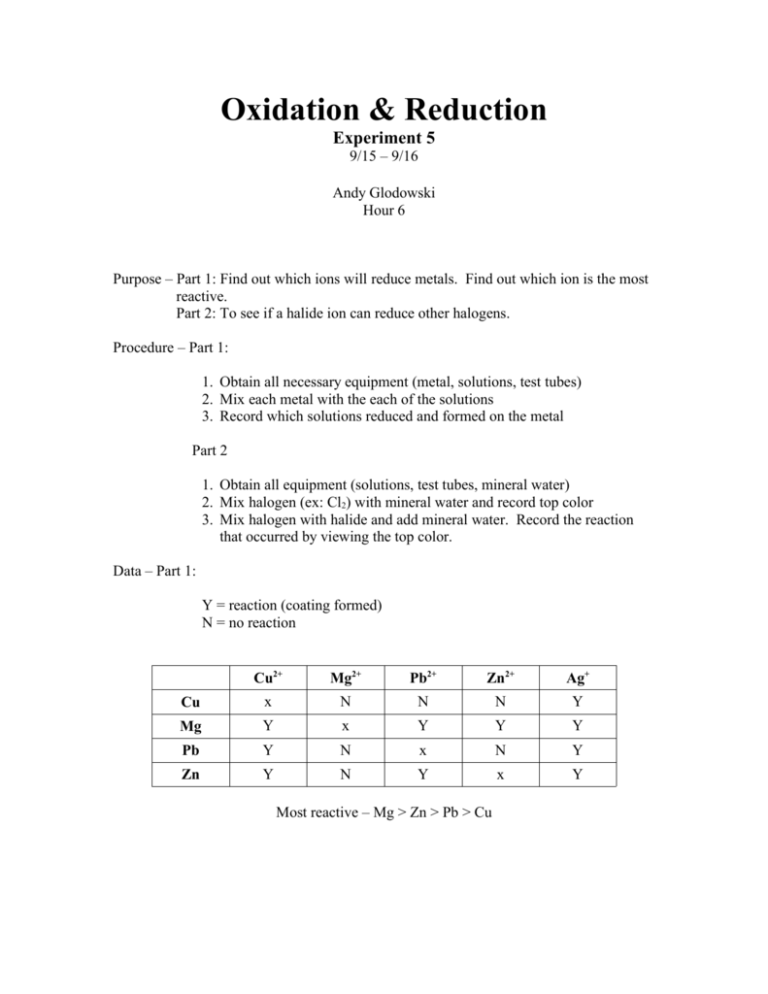
Oxidation & Reduction Experiment 5 9/15 – 9/16 Andy Glodowski Hour 6 Purpose – Part 1: Find out which ions will reduce metals. Find out which ion is the most reactive. Part 2: To see if a halide ion can reduce other halogens. Procedure – Part 1: 1. Obtain all necessary equipment (metal, solutions, test tubes) 2. Mix each metal with the each of the solutions 3. Record which solutions reduced and formed on the metal Part 2 1. Obtain all equipment (solutions, test tubes, mineral water) 2. Mix halogen (ex: Cl2) with mineral water and record top color 3. Mix halogen with halide and add mineral water. Record the reaction that occurred by viewing the top color. Data – Part 1: Y = reaction (coating formed) N = no reaction Cu2+ Mg2+ Pb2+ Zn2+ Ag+ Cu x N N N Y Mg Y x Y Y Y Pb Y N x N Y Zn Y N Y x Y Most reactive – Mg > Zn > Pb > Cu Part 2: The results that we record will be on the left. Actual on the right (if data was different than ours.) Mineral Water Cl2 Milky (faint yellow) Br2 Orange I2 Purple Mineral Water NaCl Clear KBr Clear KI Clear Halogen and Halide Oxidation and Reduction - Recorded Cl2 Cl - Br2 Actual I2 - Cl2 Br2 I2 x orange purple x clear purple Cl Br- clear x purple Br- orange x purple I- clear purple x I- purple purple x Data above – Reaction or No reaction - Recorded ClBr I- - Cl2 Br2 I2 x R NR Actual Cl2 Br2 I2 Cl- x NR NR - R x NR R R x NR x NR Br NR R x I- Most reactive – Cl > Br > I Conclusion – Part 1: The data recorded from putting the metal in the metal solution can conclude that Mg is the most reactive (easily oxidized) metal. Followed by Zn, Pb and Cu. From looking at the list of ions here is a list of the ions in the order of the easiest reduced to the hardest to be reduced: Ag ion, Cu ion, Pb ion, Zn ion and Mg ion. Part 2: This part of the lab was a little more difficult to understand, but the data recorded can tell us that the most reactive halide is I-. It is followed by Br- then Cl-. Discussion of Theory – Part 1: The reason that Mg is the most reactive is because of Effective Nuclear Charge. The Effective Nuclear Charge of Mg is 2. The other metals Effective Nuclear Charge are higher than Mg because they have more protons which also makes them harder to lose electrons. Part 2: The reason that Cl is able to take the electrons away from Br and I is because the valence electrons on Cl are closer to the nucleus, while the electrons on Br and I are further away. Sources of Error – Some of the sources of error in this experiment could have been contamination from the other tests. This could be avoided by having clean test tubes for each test. Questions 1. The net ionic equations for the reactions in part 1 are as followed. Cu + 2Ag+ --> 2Ag + Cu2+ Mg + Cu2+ --> Cu + Mg2+ Mg + Pb2+ --> Pb + Mg2+ Mg + 2Ag+ --> 2Ag + Mg2+ Pb + Cu2+ --> Cu + Pb2+ Pb + 2Ag+ --> 2Ag + Pb2+ Zn + Cu2+ --> Cu + Zn2+ Zn + Pb2+ --> Pb + Zn2+ Zn + 2Ag+ --> 2 Ag + Zn2+ 2. The metals in decreasing ease of oxidation are as follows. Mg – Zn – Pb – Cu I could not find a list to correlate with in a book. 3. The half reactions in decreasing ease of reduction are. Ag+ + e- --> Ag Cu2+ + 2e- --> Cu Pb2+ + 2e- --> Pb Zn2+ + 2e- --> Zn Mg2+ + 2e- --> Mg The lists correlate in the way that the half reactions go down the list. 4. Solvent extraction is when an organic solvent is used as an extractor to remove contaminates from something. 5. To tell if a reaction occurs in the halogen experiment the color of the top part will be the color of the halide put in the solution instead of the color of the halogen. 6. We should not expect the halides to dissolve in mineral oil because the halide is polar and the mineral oil is non-polar. 7. The net ionic equations of the halogens and halides are as follows, Cl2 + 2Br- --> Br2 + 2ClCl2 + 2I- --> I2 + 2ClBr2 + 2I- --> I2 + 2Br8. The halogens in decreasing order of reactivity is as followed. Cl > Br > I It goes down the family of family 7. It has more electrons so its easier to take them away from I and Br. 9. The half reactions for the halogens in the order of decreasing ease of reduction are as followed. Cl2 + 2e- --> 2ClBr2 + 2e- --> 2BrI2 + 2e- --> 2IThey go down the table, which means its harder to be reduced. 10.Its necessary to know the color so you can tell if a reaction has occurred when you mix the different solutions.
